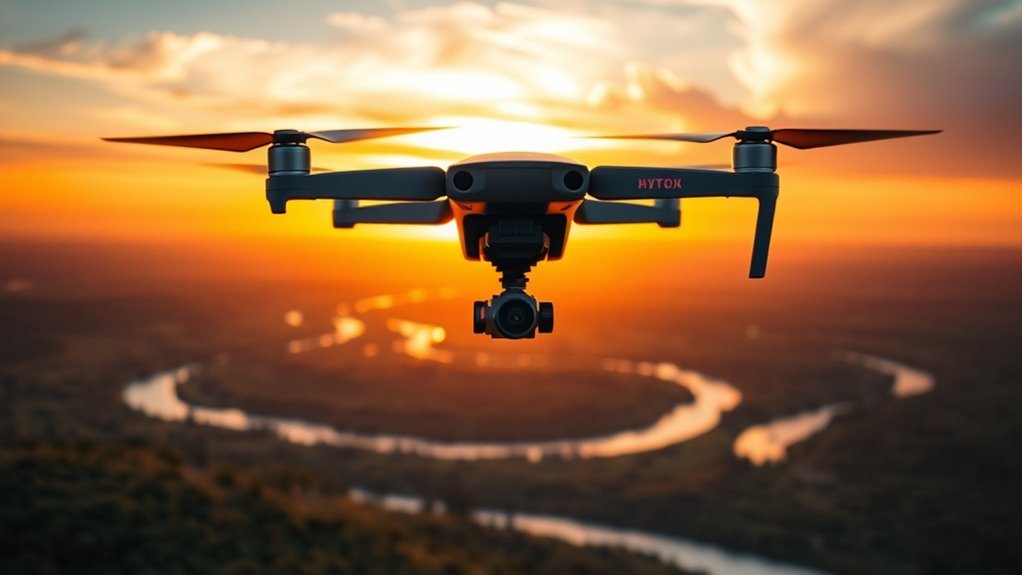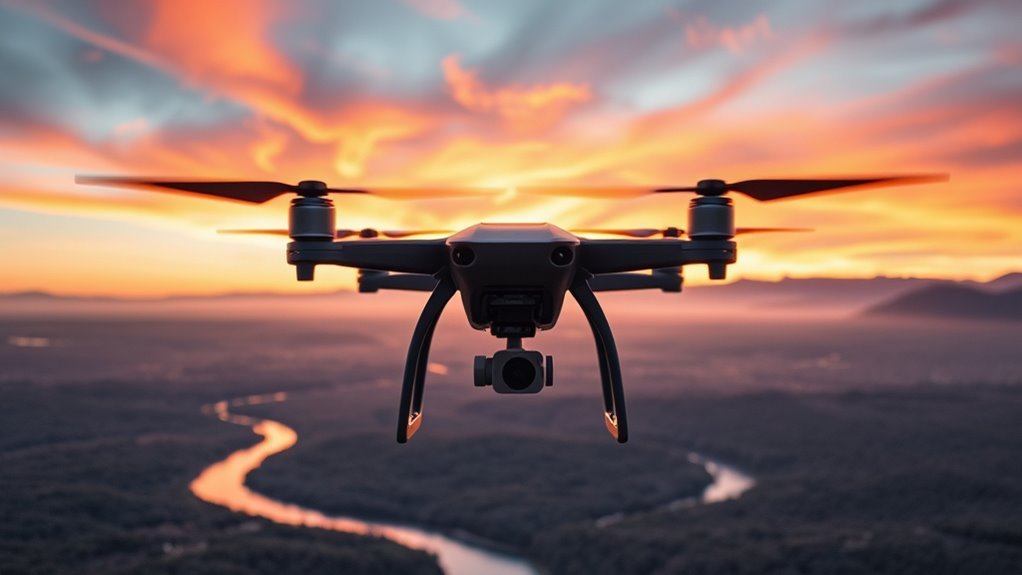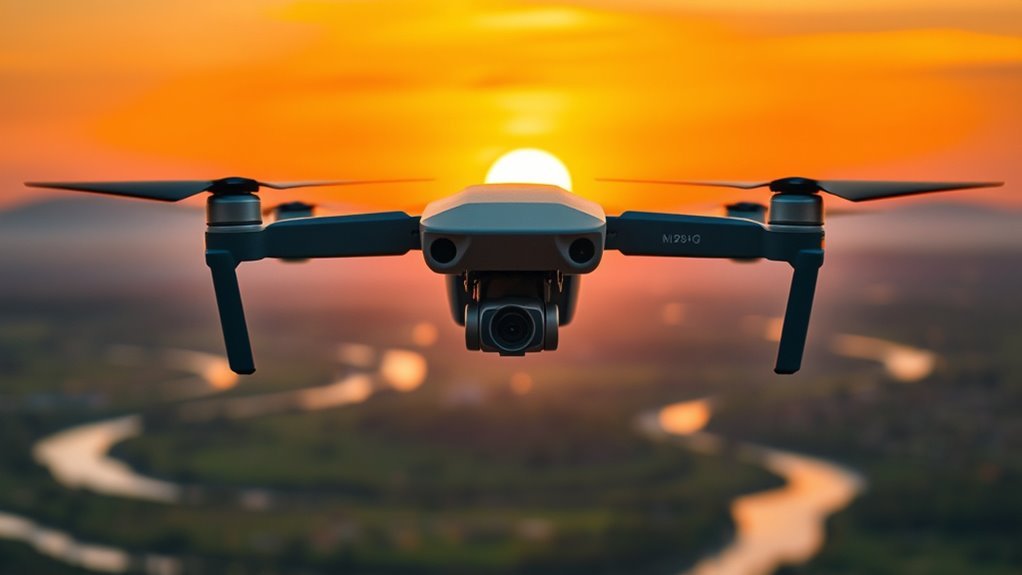Drone headless mode is a unique feature that simplifies flight control by allowing you to direct the drone based on your position, regardless of its orientation. This means forward always goes away from you, minimizing confusion, especially for beginners. It enhances the flying experience by reducing the learning curve and boosting confidence. However, it also has limitations in complex environments. For a deeper understanding of its benefits and functionalities, continue exploring further insights.
Understanding Headless Mode

Headless mode is a feature found in many drones that simplifies navigation by eliminating the need for the pilot to worry about the aircraft’s orientation. This functionality is a significant advancement in drone technology, enhancing the user experience, particularly for beginners. When you engage headless mode, the drone responds based on your control inputs rather than its physical direction. This means you can control the drone intuitively, moving it forward, backward, left, or right relative to your position, rather than its nose. Such a feature liberates you from the complexities of traditional flying, allowing for a more enjoyable and less stressful experience. Ultimately, headless mode empowers pilots to focus on exploration and creativity, making drone flight accessible to a broader audience.
How Headless Mode Works

In headless mode, the drone’s orientation becomes irrelevant, allowing you to control it based on your perspective rather than its front-facing direction. This feature simplifies the flying experience, making it easier for you to maneuver without worrying about the drone’s heading. As a result, your confidence as a pilot increases, enabling you to focus more on the task at hand.
Orientation Independent Flying
When flying a drone, understanding its orientation can often be a challenge, especially for beginners. This is where headless mode comes in, allowing you to fly without needing to constantly adjust to the drone’s direction. Instead of relying on traditional orientation techniques, you can focus on the drone’s movements relative to your position. This enhances flight stability, making it simpler to execute maneuvers. With headless mode activated, moving the control stick forward always propels the drone away from you, regardless of which way it’s facing. This feature liberates you from the complexities of orientation, enabling a more intuitive flying experience. By minimizing disorientation, you can concentrate on exploring the skies with confidence and ease.
Simplified Control Experience
Understanding how headless mode simplifies control can greatly enhance your flying experience. This technology allows you to pilot your drone without worrying about its orientation, providing you with simplified navigation. When you engage headless mode, the drone’s front aligns with your remote control’s direction, making intuitive controls a reality. You can push forward to fly away from you, pull back to return, and turn left or right with ease, regardless of where the drone is facing. This eliminates the need for constant mental recalibration, particularly useful for beginners or those seeking freedom in their flight. With headless mode, you’re empowered to focus on the experience itself, enhancing your enjoyment while minimizing frustration typically associated with traditional controls.
Enhanced Pilot Confidence
Confidence in piloting a drone can greatly improve with the implementation of headless mode. This feature enhances your flying experience by prioritizing increased control and pilot reassurance. With headless mode activated, you can focus on maneuvering without worrying about the drone’s orientation. This fosters a sense of freedom and mastery, especially for novice pilots. Key benefits include:
- Simplified directional control based on your perspective
- Reduced cognitive load during flight
- Enhanced spatial awareness and navigation
- Increased confidence in complex environments
Embracing headless mode allows you to concentrate on the thrill of flying, making it easier to enjoy the experience while minimizing the risks associated with misorientation. This ultimately cultivates a more empowering and enjoyable piloting journey.
Benefits of Using Headless Mode

Headless mode offers significant advantages for drone operators, particularly in simplifying control and enhancing the flying experience. This user-friendly design allows you to pilot your drone without worrying about its orientation. For beginners, this means a lower learning curve, enabling you to focus on getting comfortable with flying rather than struggling with directional controls. You’re empowered to fly your drone freely, as headless mode eliminates confusion when the drone is facing away from you. This feature not only boosts your confidence but also enhances your overall control during flight. With beginner accessibility at the forefront, you can explore the skies with less frustration, maximizing your enjoyment and freedom while mastering drone operation.
When to Use Headless Mode
While flying in unfamiliar environments or when piloting a drone with limited experience, using headless mode can greatly enhance your control. This feature simplifies navigation by allowing you to focus on flying rather than the drone’s orientation. Here are some key situations when headless mode is beneficial:
Using headless mode can significantly improve control, especially for new pilots and in challenging environments.
- New Pilots: It helps beginners gain confidence without getting overwhelmed.
- Challenging Terrain: Use it in areas with obstacles where spatial awareness is compromised.
- Long-Distance Flights: Headless mode can prevent disorientation, keeping your drone on course.
- Freestyle Flying: It allows for more freedom in aerial stunts without worrying about directional controls.
While headless mode advantages are clear, be mindful of its disadvantages, such as potential loss of orientation in advanced maneuvers.
Limitations of Headless Mode
While headless mode simplifies navigation, it can introduce significant challenges, particularly in complex flight environments. You might find that the drone’s response becomes less predictable, especially at greater distances. Additionally, the limited range in headless mode can restrict your operational capabilities, affecting overall performance.
Navigation Challenges
Controlling a drone in headless mode can be deceptively simple, yet it presents several challenges that can hinder effective control. You might find yourself struggling with navigation strategies, especially when faced with various drone obstacles. These limitations can lead to frustrating experiences, as headless mode relies heavily on the drone’s orientation. Consider the following challenges:
- Loss of Direction: It can be easy to lose track of where the drone is headed.
- Confusing Orientation: Sudden changes in position may confuse your commands.
- Obstacle Avoidance: Without proper awareness of surroundings, collisions become more likely.
- Dependence on Technology: Any malfunction in the system can drastically affect control.
Understanding these challenges can help you navigate effectively, enhancing your flying experience.
Flight Range Limitations
When operating a drone in headless mode, flight range limitations can considerably affect your control and overall experience. You’ll notice that the maximum flight distance is often reduced compared to standard mode. This is mainly due to signal interference, which can disrupt communication between the drone and the transmitter. If you venture too far, you risk losing connection, resulting in erratic behavior or a crash.
| Factor | Impact on Flight | Recommendations |
|---|---|---|
| Flight Distance | Limited control | Stay within range |
| Signal Interference | Loss of signal | Avoid obstacles |
| Battery Life | Decreases range | Monitor battery levels |
Understanding these limitations guarantees a safer, more enjoyable flight experience.
Comparing Headless Mode to Normal Flight Mode
Understanding the differences between headless mode and normal flight mode is essential for maximizing your drone’s performance. In headless mode, you’ll enjoy several advantages, while normal flight mode presents unique challenges.
- Headless Mode Advantages: Simplifies control regardless of drone orientation.
- Normal Flight Challenges: Requires constant attention to drone’s direction and positioning.
- User Experience: Headless mode is more intuitive for beginners, reducing the learning curve.
- Situational Awareness: Normal mode enhances your understanding of drone dynamics and piloting skills.
Tips for Beginners in Headless Mode
To effectively use headless mode, you need to grasp its mechanics, as it alters the drone’s control response based on your perspective rather than its orientation. Start by practicing basic maneuvers in this mode to build your confidence and improve your handling skills. Mastering these fundamentals will enhance your overall flying experience and prevent common mistakes.
Understanding Headless Mode
While flying a drone can be exhilarating, maneuvering its controls might seem intimidating at first, especially for beginners. Understanding headless mode can markedly enhance your experience, offering several headless mode advantages and drone usability improvements. Here’s what to keep in mind:
- Direction Independence: You’ll control the drone based on your perspective, not its orientation.
- Ease of Control: Simplifies flying, essential for those new to drone operation.
- Reduced Confusion: Minimize the risk of losing track of the drone’s orientation during flight.
- Enhanced Focus: Concentrate on capturing stunning visuals without worrying about directional adjustments.
Practice Basic Maneuvers
Practicing basic maneuvers in headless mode is essential for building confidence and mastering control over your drone. Start with simple movements to enhance your drone handling skills and improve flight stability. Here’s a quick reference table to guide your practice:
| Maneuver | Description | Purpose |
|---|---|---|
| Forward Flight | Move the drone straight ahead | Develops directional control |
| Yaw Rotation | Rotate the drone left or right | Improves orientation awareness |
| Hovering | Maintain a steady position in the air | Enhances stability skills |
Popular Drones With Headless Mode Feature
As the demand for user-friendly drones continues to rise, several models have emerged that incorporate headless mode—a feature designed to simplify navigation by aligning the drone’s movements with the pilot’s perspective. This functionality offers headless mode advantages, making it appealing for novice and experienced pilots alike. Here are some popular drone brands featuring headless mode:
- DJI Mini SE: Compact and easy to maneuver, ideal for casual users.
- Holy Stone HS720: Known for its stability and camera performance, perfect for aerial photography.
- Potensic D80: Offers robust features and a solid build, great for beginners.
- Snaptain SP650: Affordable and user-friendly, excellent for entry-level pilots.
These options can enhance your flying experience, giving you the freedom to explore without the steep learning curve.
Troubleshooting Common Issues in Headless Mode
Headless mode can occasionally present challenges that may disrupt your flying experience. To address common issues, first verify that your drone’s orientation is correctly calibrated before takeoff. Misalignment can cause confusion during headless mode, resulting in unexpected maneuvers. If your drone drifts or doesn’t respond as expected, it might be due to interference or low battery levels, so check those factors first. Additionally, confirm that you’re not exceeding the control range; this can lead to unresponsive flight. For headless mode troubleshooting, always refer to your drone’s manual for specific instructions. If problems persist, consider resetting your drone or updating its firmware to resolve potential software bugs. Taking these steps can enhance your flying freedom and enjoyment.
The Future of Headless Mode in Drone Technology
While advancements in drone technology continue to evolve, the development of headless mode is poised to become even more sophisticated. Future advancements in this area will likely focus on enhancing user experience and operational efficiency. You can expect several technological innovations, including:
Future advancements in headless mode will enhance user experience and operational efficiency, making drone operation simpler and more intuitive.
- Improved orientation algorithms for seamless navigation.
- Enhanced real-time feedback systems for better control.
- Integration of AI to adapt headless mode to various flight conditions.
- Development of intuitive user interfaces for novice pilots.
These innovations will not only simplify drone operation but also expand the potential applications of drones across industries. As headless mode becomes more refined, you’ll enjoy greater freedom to explore aerial photography, delivery services, and recreational flying without the complexities of traditional piloting.
Frequently Asked Questions
Can Headless Mode Be Used for All Drone Models?
Not all drones support headless mode; compatibility varies by model. While it enhances flight performance, ensuring your drone’s specifications align with this feature is essential for maximizing your aerial freedom and control during flight.
How Do I Activate Headless Mode on My Drone?
To activate headless mode on your drone, access the flight controls through the remote. Typically, you’ll press a specific button or toggle switch, enabling simplified drone navigation—allowing you to fly without worrying about orientation.
Does Headless Mode Affect Battery Life?
Headless mode doesn’t greatly impact battery performance. However, depending on your flying style and energy efficiency, it may lead to slightly increased energy consumption if you’re frequently adjusting orientation during flight.
Can I Switch Back to Normal Mode Anytime?
Sure, you can switch back to normal mode anytime, like a rebellious drone pilot! Just remember, the freedom of drone navigation comes with a learning curve. Master it, and you’ll soar with confidence!
Is Headless Mode Suitable for Professional Drone Photography?
While headless mode offers advantages like simplified control, it has photography limitations. For professional drone photography, relying solely on it might hinder your ability to capture precise angles and high-quality shots, so consider using standard mode instead.

